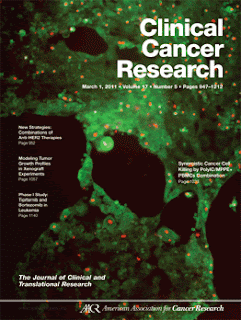martes, 15 de marzo de 2011
EGFR-Homing dsRNA Activates Cancer-Targeted Immune Response and Eliminates Disseminated EGFR-Overexpressing Tumors in Mice — Clin Cancer Res
EGFR-Homing dsRNA Activates Cancer-Targeted Immune Response and Eliminates Disseminated EGFR-Overexpressing Tumors in Mice
Alexei Shir1, Manfred Ogris2, Wolfgang Roedl2, Ernst Wagner2, and Alexander Levitzki1
+ Author Affiliations
Authors' Affiliations:1Unit of Cellular Signaling, Department of Biological Chemistry, The Hebrew University of Jerusalem, Givat Ram, Jerusalem, Israel and 2Pharmaceutical Biology-Biotechnology, Department of Pharmacy, Ludwig-Maximilians-Universität, Munich, Germany
Corresponding Author:
Alexander Levitzki, Unit of Cellular Signaling, Department of Biological Chemistry, The Hebrew University of Jerusalem, Givat Ram, Jerusalem 91904, Israel. Phone: 972-2-6585-404; Fax: 972-2-6512-958. E-mail: alex.levitzki@mail.huji.ac.il
Abstract
Purpose: The cause of most cancer deaths is incurable dissemination of cancer cells into vital organs. Current systemic therapies for disseminated cancers provide limited efficacy and are often accompanied by toxic side effects. We have recently shown that local application of epidermal growth factor receptor (EGFR)–targeted polyinosine-cytosine (polyIC) eradicates preestablished EGFR-overexpressing tumors. Here we show for the first time the high efficiency of systemic application of polyIC/melittin-polyethyleneimine-polyethyleneglycol-EGF (polyIC/MPPE) in combination with human immune cells.
Experimental design: Cancer-targeted activation of immune cells was examined in vitro and in vivo following transfection with polyIC/MPPE. The therapeutic efficiency of the strategy was then examined on disseminated EGFR-overexpressing tumors grown in severe combined immunodeficient (SCID) mice.
Results: Intravenous delivery of polyIC/MPPE followed by intraperitoneal injection of peripheral blood mononuclear cells induced the complete cure of SCID mice with preestablished disseminated EGFR-overexpressing tumors, with no adverse toxic effects. The immune cells and the cytokines they produce are localized to the tumor site of the treated animal and contribute decisively to the demise of the tumor cells. The immune system homes to the tumors, due to the chemokines produced by the internalized polyIC.
Conclusion: The EGFR-homing vector loaded with polyIC can be used to treat and possibly cure patients with disseminated EGFR-overexpressing tumors. The possibility of adopting this strategy to treat other tumors that express a protein capable of ligand induced internalization is discussed. Clin Cancer Res; 17(5); 1033–43. ©2010 AACR.
Footnotes
Note: Supplementary data for this article are available at Clinical Cancer Research Online (http://clincancerres.aacrjournals.org/).
Received May 2, 2010.
Revision received October 3, 2010.
Accepted November 25, 2010.
©2010 American Association for Cancer Research.
EGFR-Homing dsRNA Activates Cancer-Targeted Immune Response and Eliminates Disseminated EGFR-Overexpressing Tumors in Mice — Clin Cancer Res
Suscribirse a:
Enviar comentarios (Atom)























.png)











No hay comentarios:
Publicar un comentario